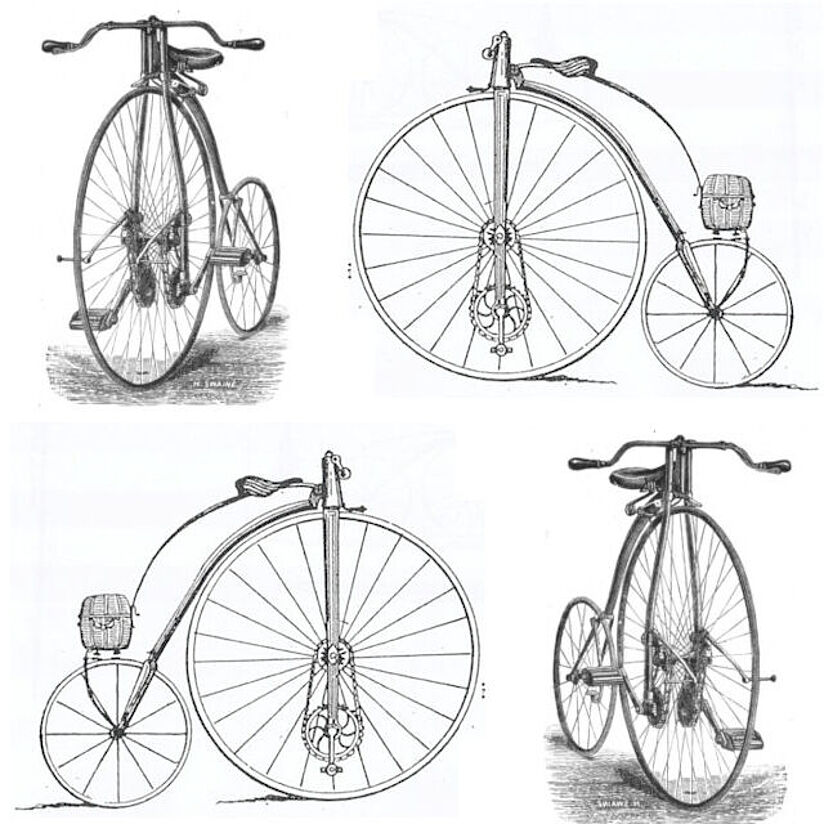
Bild: Outing and the Wheelman Band 5 1885 S. 488, Le Vélocipède Illustré 1 Mai 1883
Multiple Inventions in the History of Technology
Workshop 23.-25.07.2025 Deutsches Museum, Seminarraum Forschung I
Deutsches Museum Munich, The Cohn Institute for history and philosophy of science and ideas
A joint workshop supported by the DFG
Independent inventions of a similar device or method by separate groups is a highly common phenomenon in the development of technology. Indeed, the concept of simultaneous, multiple or parallel discovery and invention, developed to examine such cases, is well known and has attracted considerable scholarly attention. Yet, most of it concentrated on discoveries. Inventions received less attention. This is unfortunate since the multiplicity of inventions allows the historian comparing the paths of the different groups involved and teaches us thereby both on the resources that the inventions required and the social, technical and other factors that motivated the research towards them. By discussing the results of pre-circulated drafts papers of close historical studies of specific duplications, we aim to surpass truisms like ‘inventions are the product of their time’ by indicating the specific factors that made these inventions feasible and desirable at particular time and place. Moreover, these studies will help to indicate conditions under which multiple inventions are more likely to appear, and thus to better understand the process of invention and technological development in general.
Our studies range from re-examining famous multiples, like that of the telephone to exploring unexamined ones like that of the dye-laser. In response to criticism about the concept of multiples, to unjustified claimed of alleged multiples in the literature and to neglect of genuine multiples in other cases, we offer a concrete and careful historical and conceptual analysis of the cases. Each invention is examined within its contemporary understanding and context, to determine what was its novelty, and to what extent was it a multiple. The degree of similarity needed and the exchange of knowledge between the groups allowed for inventions to be regarded as multiples are examined through the particular cases. To this end we suggest precise and concrete definitions of the inventions on their technical part and their function. Such a definition turns out to be crucial for understanding the process of invention.
Organisation and Speakers
Organizers: Johannes-Geert Hagmann, Deutsches Museum and Shaul Katzir, Tel Aviv University
Luise Allendorf-Höfer, Deutsches Museum
Klodian Coko, Tel Aviv University
Frank Dittmann, Deutsches Museum
Sungook Hong, Seoul National University
Benjamin Johnson, independent scholar
Jad Kadan, Tel Aviv University
Cornelia Kemp , Deutsches Museum
Rich Kremer, Dartmouth College
Timo Mappes, Universität Jena and Deutsches Optisches Museum
Rudolf Seising, Deutsches Museum
Climério Silva Neto, Federal University of Bahia and Alexei Kojevnikov, University of British Columbia
Anthony S. Travis, The Hebrew University of Jerusalem
Draft Programme
Wednesday, 23 July 2025
13:00 Arrival
First Session, chair: Johannes-Geert Hagmann
13:45 Welcome, Introduction and methodological considerations - Shaul Katzir, Tel Aviv University
14:20 Rudolf Seising: “The multiple invention of the learning machine”
15:20 Jad Kadan: “Multiple Inventions in History of Computing: Core memory and Programming
Automation”
16:10 Coffee break
Second session, chair: Frank Dittmann
16:40 Benjamin Johnson: “Hybrid Inventions: The Combination of Empirical and Theoretical
Aspects of Ammonia Synthesis from the Elements”
17:40 Anthony S. Travis, The Hebrew University of Jerusalem: “Technologies of Synthetic Ammonia in the 1920s”
18:30 Break and transfer to dinner
Thursday, 24 July 2025
Third session, chair Alexei Kojevnikov
9:10 Songook Hong (remote participation): “Why were there so many multiple inventions
in the history of wireless telegraphy?”
10:10 Luise Allendorf-Hoefer: “The multiple invention of the Transistor”
11:00 Coffee break
11:30 Frank Dittmann: “Transformer – a (difficult) example for Multiple Invention in electrical
engineering”
12:20 Lunch break
14:00 Short museum visit / guided tour
Forth session, chair Shaul Katzir
15:00 Alexei Kojevnikov + Climerio da Silva Neto: “The Invention of Solid-State and Semiconductor
lasers in the Soviet Union”
15:50 Johannes-Geert Hagmann: “Tunable coherent light: the multiple invention and discovery
of the dye laser”
16:50 Coffee break
17:20 Rich Kremer: "Simultaneous applications of conical pendula in clocks, steam engines and
large telescope mounts circa 1800”
18:00 Break and transfer to dinner
Friday, 25 July 2025
9:00 Cornelia Kemp: “A problem that promises so much: The international origin of photography”
10:00 Klodian Coko: “The Multiple Invention of the Telephone”
10:50 Coffee break
11:20 Timo Mappes: “Ultramicroscopy re-invented after its centennial”
12:20 Concluding discussion
13:00 Light lunch and farewell



